You are reading the older HTML site
Positive Feedback ISSUE
march/april 2008
Final Impressions: The Lamm LL2 Preamplifier
(Deluxe Version)
by David W. Robinson
[All images and image processing by Robinson, unless otherwise noted.]
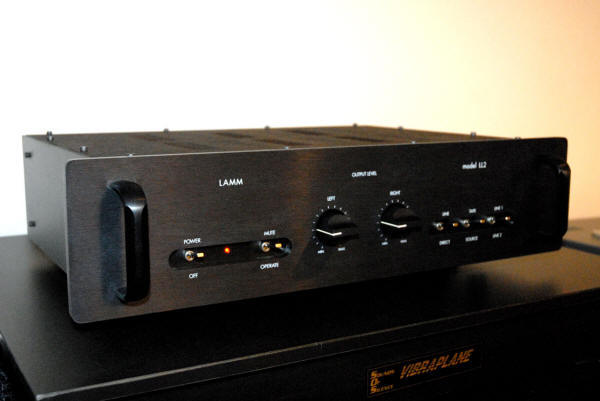
Vladimir's Stealth Bomber: the Lamm LL2 preamp
In which our hero meditates…
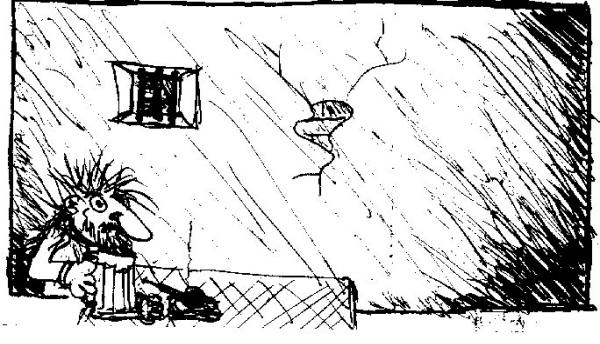
"Surprised by joy"
Note to self: life in the audio lane can be pretty mundane. If you're not careful, you'll get jaded…lose track of your desire, the passion that drove you into audiomania in the first place.
Nineteen years into audio reviewing: It's a lot harder to be sucker-punched by a component than it used to be. (Obvious parallels to romance abound here.) The more you've heard, the more it takes to hit the "oh yeah!" zone. Like Thurgood Marshall and pornography, you can't define it, but you know it when you see it. Sometimes you'll go quite a while without hearing anything that floats your boat …which, frankly, can make you persona non grata with those designers who are working very hard to get your audio vessel waterborne.
Then again, there are those times when a component comes along, and no matter how much experience you may have, how much listening you've done, you're amazed at the quality of what you're hearing.
And this is one of those times.
The Lamm LL2 came in quite a while back as an item that Dr. S. was going to work with. Due to a landslide of projects that all arrived at about the same time, he sent up smoke signals and asked me to take it over. I was willing to do it, but had a handful of components that I was working with, and had to queue it up, waiting for a time at which I could drop it into play without changing other variables. That meant that it wasn't until the late fall of last year that I was finally ready to put the LL2 to the test.
The setting was friendly, though; the LL2 was going to be the preamp to its own Lamm M1.2 Reference monoblocks, which were hybrid amplifiers that I raved about in my Brutus awards for 2006 (see PFO Issue 28), and my subsequent review (see PFO Issue 34). While the LL2 isn't the top o' the heap for Lamm…that distinction belongs to its big brother, the L2 (which, given what happened with the LL2's, I hope to review within the next year)…my time with the M1.2's had increased my expectations for anything with a "Lamm" sticker on it. Frankly, I would have been surprised if the combination of the LL2 and the M1.2 Ref's had been disappointing.
But I really wasn't quite prepared for how good this preamp was. For more, read on…
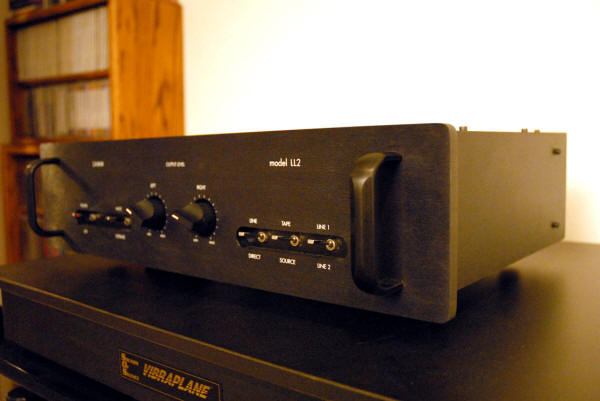
Hardware profile and specifications
The Lamm LL2 is a classic-looking one-box tubed preamp, simple and elegant in design. Its layout includes a pair of 12AU7A's in the first stage, a pair of 6DJ8's in the second stage, and a 6X4 functioning as a full wave voltage rectifier. (Lamm does have a healthy list of acceptable tube substitutions for these tubes listed in the documentation, a good thing when it comes to tubed components.) It is Pure Class A, single-ended in all circuit stages, and single-ended (RCA) output only. Lamm has concentrated on the fundamentals, with only the essential preamp functions provided for. Switches and controls include power, mute/operate, left and right volume pots (stepped attenuators with a very fine soft detent feel to them), line/direct, tape/source, and Line 1/Line 2 input selectors. The rear of the LL2 has gold-plated inputs, three pair of which are for Line 1, Line 2, and Direct. The Direct input bypasses all other switching/looping options, and goes straight to the volume pots. In a very pleasant throwback, Lamm has provided RCA ports for a tape loop, giving you another input/output set. I'd like to see more of this again in fine audio preamps; it's useful to have, and a serious pain if you need it and don't have it. The back panel is rounded out with two output sets, plus an Earth tap.
Lamm lists the LL2 as a non-phase (or polarity) inverting preamp, always a very important specification to know with preamps. The only important function that I missed in the LL2 was a Phase (or polarity) Invert, as there are recordings that benefit from this feature. Couch potatoes, beware: there is no remote with the LL2, so you'll have to make adjustments the old-fashioned way. This never bothers me, but there are a number of listeners who really don't like to get up and down to adjust their preamps. Power up on the LL2 is auto-muted for 40-45 seconds (indicated by the power LED flashing), allowing the preamp to hit stability before becoming operational. This is always an excellent feature in a preamp. It's too easy to forget that your amps are already on when you turn on your preamp—and your speakers will not appreciate the result. Likewise, an instantaneous auto-mute protects your speakers during the power-off cycle. Me, I almost always turn volume to zero and turn off my amplifiers before my preamp/sources anyway, but this is another welcome layer of insurance against "I forgot."
Lamm's published specifications are, as always, exemplary in their scope and thoroughness. (See Lamm's web page for extended specs, http://www.lammindustries.com/PRODUCTS/LL2spec.html. One could wish that all spec sets were as comprehensively stated as these.) The highlights for me: a claimed frequency response of 20Hz – 20KHz +/-0dB, 1.5Hz – 400KHz -3dB; a relatively quick slew rate of 41 Volts per microsecond; a signal-to-noise ratio of >84dB; an input impedance of 50K Ohms; an output impedance of 250 Ohms.
Finally, the LL2 tips the balance beam at 20 pounds, and measures 19" W x 4.5" H x 13.9" D (15.1" including front handles), which is a reasonable compact form. Lamm claims to burn in each LL2 for at least 72 hours, a very good thing when it comes to quality assurance, and also to getting some break-in mileage on internal components before receiving a preamplifier. Lamm's warranty is five year, non-transferrable, upon registration of the warranty.
The internal parts and pieces show intelligence and discrimination in their selection. There are no generic parts here: Lamm states that it uses Dale metal film resistors, Electrocube and Roederstein film capacitors, high frequency switching-grade Cornell Dubilier electrolytic capacitors, and Alps stepped volume controls. The power transformer is a "custom" design for this preamp. Readers need to know that there are two version of the LL2: a "regular" model, and a "deluxe." Both employ the same chassis, PCB, and switching, but the Deluxe takes the base model and adds double the Joule boxes for significantly increased energy storage. This results in greater dynamics and better handling of sudden power demands on the part of the music signal passing through the LL2. Frankly, given the fact that the price differential between the two models is only $300 (MSRP of $4690 for the Regular version, versus $4990 for the Deluxe), I would say that the upgrade to the Deluxe is obvious. Do it!
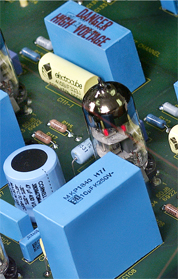
LL2 Deluxe power storage with its doubled capacity over the Standard model (image courtesy of Lamm Industries, Inc.)
The Deluxe model also adds parallel polystyrene capacitors to the film caps in critical signal paths.
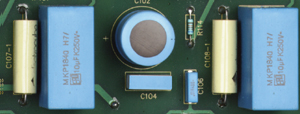
LL2 Deluxe high-quality parallel capacitors are the yellow components in the circuitry above (image courtesy of Lamm Industries, Inc.)
The LL2 partakes of the family styling of the Lamm line: brush-black with well-screened white lettering. The construction is very solid, with excellent finish; there are no sharp edges, no evidence of sloppy fabrication …all in all, a sturdy preamp, with a workmanlike look to it. Some audiophiles might find the look and feel of the LL2 to be unremarkable …there are those who really prefer naked tubes in all their glowing glory…but the most important thing to me is how a component sounds.
And this is where Vladimir Lamm has slipped in his little stealth bomber, right under our collective radars….
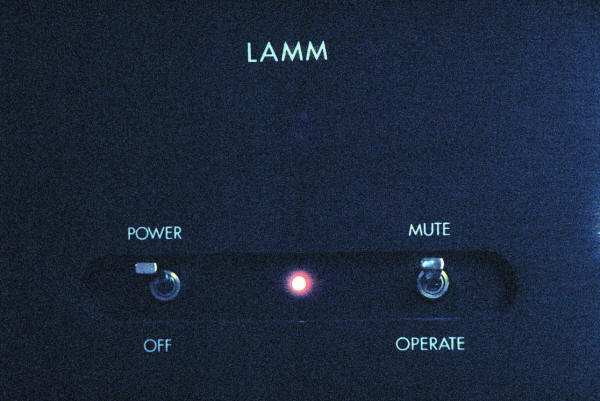
The rest of the chain
I put the LL2 in my listening room in the place of the superb EMM Labs DCC2 SE, a very tough act to follow. Upstream of the LL2 was the Teac Esoteric DV-60, a superb universal player that I have fallen in love with. (See my review of the DV-60 in PFO Issue 34.) Additionally, I had the Halcro EC800 universal player available (impressions forthcoming). Power cabling for the LL2 was provided by the excellent Silent Source Music Reference, with Symphony unbalanced interconnects by JENA Labs for the DV-60 and the EC800.
Downstream were my trusty M1.2 Reference hybrid monoblocks, fed by a custom-built shielded JENA Labs Solo unbalanced from the preamp. The M1.2's were power cabled with Silent Source Music Reference and plugged to my Walker Audio Velocitor Power Line Enhancers (2 units, each to a dedicated 20 amp circuit); the path to my Nova Rendition II speakers/Townshend Super Tweeters was cabled with Silent Source Music Reference (midrange/tweets/supertweets) and JENA Labs Fugue (bass), all treated with Walker Audio Extreme SST Contact Enhancer.
This combination has been in place throughout much of the past year, and is very well known to me. If the LL2 had strengths or weaknesses, I would know it pretty quickly.
I should point out that the LL2 installed without hassle …no hassle with tubes or failures right out of the box…fired up exactly as the documentation described, and ran without a single problem for months. (If only this were true of every review sample that I've dealt with.) Solid performance that simply worked, and worked, and worked. You know, I really like it when things work. The folks at Lamm clearly know their stuff …well done, Vladimir!
Not only that, but the LL2 is exceptionally quiet. No RFI at all, which can be a bugaboo up here on top of the hill (750 feet up overlooking River City), and no 60 Hz hum at all. My highest praise to Lamm: the tandem of the LL2 preamp and the M1.2 Reference hybrid monoblocks has a noise floor that made me delighted to be listening. Every time. Tubed gear doesn't always achieve this extremely important design goal—and who doesn't hate a nasty hum in the middle of their music?
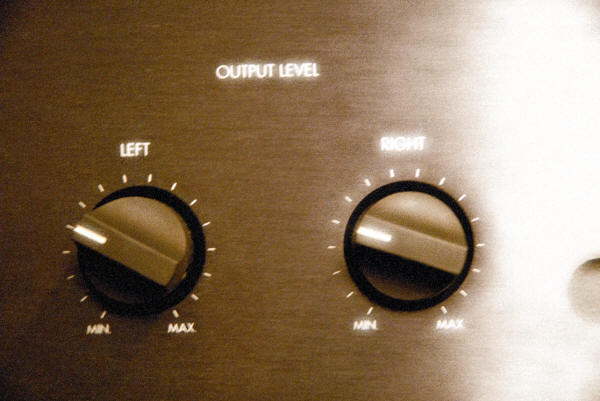
The sound
True confession time: While I had been knocked out by the superlative M1.2 Reference hybrid monoblocks, those sly dogs, I wasn't necessarily expecting the same sort of sucker punch from the LL2. Yes, I hoped and expected it to be good, now that I was familiar with the over-achievement of the M1.2's; but it's not like I anticipated that I was going to be surprised or taken aback. I don't know why this is—maybe it was because of the unassuming appearance of the LL2, or perhaps it was its trim, no-nonsense form factor and control set. You'd think that I'd know better by now; you'd think that I should have been approaching my time with the LL2 with crafty enthusiasm and chortles of "This is going to be great!" Instead, all was businesslike: out of the sturdy packing crate that Lamm always uses, past all the excellent documentation, and into place with the beastie. Heat it up for a day or two, then let ‘er rip.
My first impression of the LL2 was—bemusement. Regardless of warm-up and a brief run-out, many preamps right out of the box wrestle with nasties like sounding congested (an inability to properly render more complex recordings tonally/dimensionally), or dark (rolled-off higher frequencies, favoring mid-bass to midrange), or a bit nasal/"honky" (emphasis on midrange with both lower and higher frequencies rolled off somewhat), or even a bit grainy (a dry and forward presentation of audio texture without accompanying harmonic and tonal richness). Superior preamps soon shrug those break-in problems off after a few dozen hours, and will begin to bloom into their natural stature, taking their listeners along through the process.
Not the LL2.
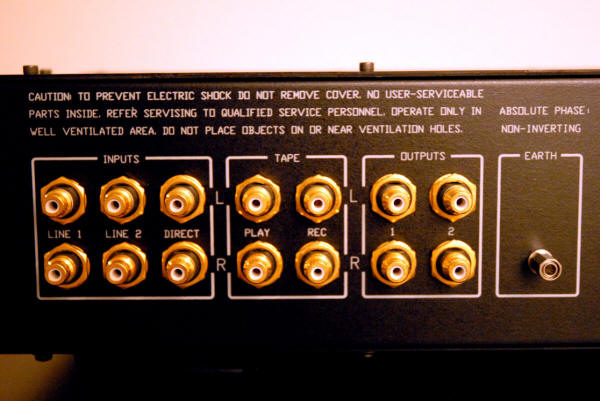
Granted that I had given this preamp a couple of days to get good and warm, running some SACDs through it just to put some miles on the circuits. But I hadn't put an enormous amount of time in; certainly not enough to complete a break-in. What was going on? In the very first listening session, I became aware of the fact that the LL2 was sounding relaxed and free of constrictions. I was not wincing and saying to myself, yet again, "Well, give it a week or two …then we'll see." Instead, I found myself sitting down and actually listening to the music through this preamp from that first moment. Que pasa?
Later on, while reading through the documentation, I found a fact that may help to explain my initial experience. Lamm lists the burn-in time at the factory as a minimum of 72 hours, which is actually a respectable stretch of time. This could explain why the LL2 sounded so fine to my ears right out of the box…then again, perhaps this was a review sample with previous stops in its career. Who knows? Regardless, the Lamm unit impressed me from the very first.
The first thing that I noticed was that the LL2 was harmonically rich, and tonally right. At first, I was tempted to say "warm," but on second thought, I don't think that's right. You can get "warmth" with a preamp or amp if there's a mid-bass bump, and a light roll-off of the higher frequencies, but that's definitely not what's happening here. There is no roll-off in the higher frequencies, and the mid-bass is not emphasized; the rendering of detail is excellent, and the extension of higher frequencies is very fine. The midrange was superb no matter what I ran through it, though the LSO SACD of Sibelius' Kullervo was a particular treat, one that I listened to in its entirety more than once with the LL2. The massed voices of the male choir …the back and forth interplay between male and female soloists …all sounded right to me. I found nothing that was nasal, no midrange imposition on its neighboring frequency ranges; no bad habits at all. No, I've come to the conclusion that what I'm hearing is an excellent tonal balance and a presentation of harmonic structure that resonates at the level of soul. The LL2 makes music, and makes it richly…without pulling euphonic tricks out of a hat.
On favorite SACDs of mine like The Spirit of Gambo or Joe Weed and the Vultures (a leap of centuries there …baroque meets The Ventures), the combination of detail…of string, whether plucked, hammered, or bowed …was extremely pleasing to me. There was not a hint of grain or astringency in the LL2's tonal presentation; instead, the harmonic envelope around the strings caressed me, feeling living and real. Chorale music like Sun, Moon and Stars: Baroque Music from South America, 2 on Hyperion SACD, particularly the first track, demonstrated a haunting quality via the LL2 that, to my surprise, seemed to give up little to the superb EMM Labs DCC2 SE processor/preamp. There was no hint of any roll-off, no sense of romance in the LL2's performance.
Musical, yes. Incisive, yes.
"Colored" or "euphonic," definitely not.
Another smashing SACD, absolutely essential if you want to enjoy rich harmonics and timbre that are spot on, is the Netherlands Wind Ensemble's Mozart: Serenade K361, Gran Partita on NBE. If you don't have this SACD, order it immediately…you'll thank me later. It's an acid test for texture, timbre, and intonation of wind instruments; the LL2 passed with flying colors, filling my listening room with glory, and me with real delight.
Another of my favorite all-time reference recordings on SACD is Reiner and the CSO's Scheherazade on RCA. Whether or SACD or LP, this recording definitely gives you a fine baseline for system dynamics (both macro- and micro-), string tone, and soundstaging. More importantly, it's a masterful performance of a smashing composition. I've used it as a real acid test for a number of years now; if a preamp does well with this recording, it will likely do well with all recordings. The LL2 passed the test with flying colors: the dynamics here were excellent, from piano to fortissimo. The massed violins exhibited no steeliness, but had a rightness of harmonics and attack that was very appealing. As a long-time fan of this RCA LSC, I heartily approve!
The LL2 also scored well in the category of transparency, that quality sometimes described as a "lack of veiling," "immediacy," or "presence." (I've got to write an audio glossary some day.) Some recordings will reveal this quality much better than others, of course; there are discs that are the equivalent of audio Cheese Whiz, Twinkies, or cheap sausages: overly processed, muddy, and unpalatable. You know: like much of our contemporary music encoded on inferior encoders at low bit rates and played back on cheap MP3 players. Like that. You can't tell much about this vital quality without using superior recordings. To assess the LL2's relative transparency, I used a pile of SACDs from Top Music (pick any title you like), Channel Classics (ditto), various titles from BIS and Hyperion (what terrific work!), First Impression Music, and some of my Japanese SACDs (JSACDs) from Exton (classical, mainly Rachmaninoff) and Sony (some Miles Davis and Getz/Gilberto here), all of them spinning on the Teac Esoteric DV-60 as a source. While the DV-60 doesn't achieve the current zenith of tonal clarity represented by the EMM Labs CDSD SE/DCC2 SE combination, it's no slouch either. And the results were uniformly superior: the LL2 showed fine clarity while maintaining tonal balance on every reference SACD I played. Week after week; month after month.
The soundstaging of the LL2 didn't run any risk of claustrophobia, either. Naturally those recordings that were soundstaging gems (e.g., the SACDs of Cantate Domino, or Carmina Burana on Telarc) sounded terrific, with fine width and depth of presentation. The back wall of my listening room did its usual vanishing act with the LL2, something that it does with superior playback of SACD and LP sources (but does not do nearly so well with CDs). Imaging was also very fine: the SACDs of Beck's Sea Change and Super Furry Animals' Love Kraft made me jump with the movement of instruments and sound effects via the Lamm: Q Sound on steroids here. (Alternative rock on SACD can really sound great; if you like A-Rock and don't have these titles, you really should add them to your collection. Thank me later.)
Audio dimensionality and placement score: first-rate.
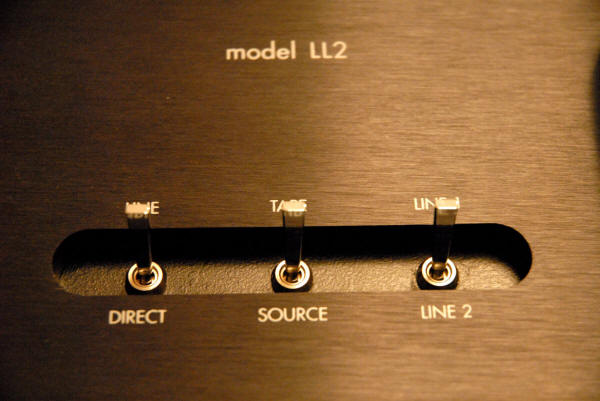
Conclusion
The Lamm LL2 is a surprisingly fine preamp. I suppose that it won't scratch every itch—few designs do. For example, anyone who cannot function without a remote control had better look somewhere else. (Either that… or get up off your backside and get some exercise!) Those who have genuine needs for balanced I/O, or who need more than two inputs plus record loop, may well need to look elsewhere. And audiophiles who are lost without a polarity/phase inverter will have to give thought to their alternatives.
But if that isn't you, and your budget can go the $5K price tag, then I'd say that you absolutely must give the Lamm LL2 very, very serious consideration. This is a no-frills design that delivers musical delights at every turn. In fact, this could easily be many people's last preamp. I certainly could have lived with it for much longer than it was active in my listening room, and I was truly sorry to ship it back to Lamm.
What else can I say? Vladimir and Company sent over a Stealth Bomber with their LL2 …it got in under my radar …and I got knocked out. This straightforward, unassuming unit got into my listening room—then it got into my heart. I can't remember hearing any preamp that I liked better than this preamp in the $5K-and-under category, and I've heard more than a few. It finds a sweet spot that brings together harmonic richness and terrific sonic presentation, and makes them serve the music with real authority.
The verdict? The Lamm LL2 preamp receives "Ye Olde Editor's Highest Recommendation"…with affectionate enthusiasm.
And I hereby underline my Brutus Award for 2007.
Lamm Industries, Inc.
2621 East 24th Street
Brooklyn, NY 11235 USA
TEL: 718. 368. 0181
web address:
www.lammindustries.com
email address:
[email protected]
